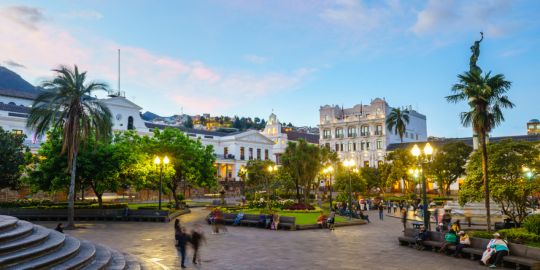How to save Money on Your Duty Free Shipping
So you’ve decided to make beautiful Ecuador your home! Congratulations! Now, you will face a very difficult decision: Do you ship your precious household items which you have acquired over a lifetime, or do you sell everything, give it away or store it and then just buy what you need once you get to Ecuador?
The first consideration is the cost. Don't let anyone lead you astray or minimize the cost of shipping your household items. Depending on where you ship from, your total cost will be determined by the size of container you need (40 ft or 20 ft, or multiples). The costs for shipping from the Midwest USA to Guayaquil will probably range from about $4,800 to $5,200 for the average size household and will include the charges as outlined below: The second cost is from Guayaquil to your home destinations, that will be around $4,300 for everything.
Stateside Packing
The first cost you will incur is for the stateside packing of your items. You may save money by doing the packing yourself, but you will need some professional counseling in order to do it correctly. Packing for international shipping, in a container, is not the same as packing to ship across your country over the freeway and smooth roads. In addition, the customs requirements for Ecuador will have to be met. !
Shipping companies may provide you with a quote. However, remember that the basic quotes may in fact have additional costs tacked on. Every precious valuable item that must be specially packed or crated may cause an additional charge from $145 to $300 dollars depending on the crate size. Just putting your excellent mattress in a water poof package is an additional charge.
All your furniture items should be tagged and numbered. All your boxes should contain detailed lists of all items contained in the box. You or your agent should then check off each item and/or box as it is loaded in and unloaded from the container. One suggestion is to make sure that you take your own pictures of all items before packing, loading and then after unloading ' for insurance purposes. Also, request copies of any pictures your shipping company may have taken. If you're coming to Ecuador, most US or Canadian shipping companies do not know the customs requirements for the packing list. (They will argue that inventory and lists is not necessary ' don't believe them!) This list is totally different from the usual packing list the Packer or shipper is used to doing, and it must be very detailed.
Hints to help you pack so that your valuables arrive unbroken:
-
You must pack each item very well and with extra padding (there is much movement on cargo ships).
-
Add very large red 'fragile' stickers in many (i.e., each side of box) very easy to see places on each fragile box. Remember the Ecuadorian unloading your things doesn't speak English, so Spanish is best when writing the fragile label. (fragíl)
-
When loading your items in the container put the fragile items on top and be sure they are secured.
-
On all your fragile and clothing items use commercial grade sturdy boxes. Used store boxes can be very costly in the long run.
Loading and Blocking
Another cost incurred is in loading and blocking the container. The usual charge for this is from $90 to $150 an hour with a four hour minimum. Do not assume that once your container is put in place, you have all the time in the world to load it. Check with each container company and find out their policy and their charges. This can add up. Some container companies will even have a policy to drop the container and allow you 24 to 48 hours to load.
Overland Charge
The next charge includes taking your container over land to the container departure station. This may not be the port of departure but the nearest container departure point from your home. It may be a railway point or a container yard. This charge will be by mileage and may include 'fuel add on' charges. Therefore, 10 to 50 miles is about $150, 100 to 200 miles about $800 and so forth. Different container companies have different departure points, and the larger companies will have more departure points which can lower your overland charges, so keep this in mind when choosing a company.
Sea Travel Cost
The next cost and the easiest to understand is the sea travel cost for your container from port of departure to Ecuador. Unless you want your container held up in Guayaquil, be sure your bill of lading has the final destination specified to be a private customs, in the customs city nearest you and that it matches your packing list and insurance value. (For example, private customs in Cuenca.)
Insurance Charges
The next charge is Insurance. This should run 1.5 to 2% per $100 of the declared value. Use 'in country insurance' if you really are concerned with insurance that will pay. You can choose your deductible rate. You are required to have an Ecuadorian insurance company insure your international sea leg. This insurance is required but will not pay in case of damage because the insurance is not collectable on used goods, only new, and you must have an identification tag on each item and the original receipt of purchase on each item to collect. So, since you are not allowed to ship new goods, it is virtually worthless, but you must have it. The up side is, it's cheap. So if you want to insure your goods you will have to have two policies. 'Welcome to South American logic!'
New enforcement of an old law: each item in a box must be listed and valued (easiest to do when you are packing). Every item in a box must be identified and the amount and the value listed on a spreadsheet. Your packing list is one of the most important items that you will put together. It must meet the Ecuadorian customs requirements and ways of doing things. It may not make sense to you, but you're not the one responsible for allowing your items into Ecuador, so be sure your Ecuadorian shipping agent has a good relationship with customs.
One of the many reasons for containers being held up in Guayaquil, even though the final destination on the Bill of Lading is the private customs agent near you, is problems with the BOL (bill of lading). There are certain things that must match and your experienced EC agent will know what these involve!
The next problem to be avoided is customs finding something wrong with the packing list or having a question about it. If you have a lot of time you can send your packing list to the nearest Ecuadorian consulate and play run around. The most efficient way is for you agent to have the packing list approved and Notarized in Ecuador.
This alternative, allows you to work with your Ecuadorian agent and they can work with local private customs and have your list notarized and approved in Ecuador.
Another problem people face involves shipping or listing forbidden items on your packing list; this will cause you a lot of problems with customs and could cost you a lot of time and money. It is also a felony if you're caught. BEWARE, many agents will tell you what you want to hear, but you're the one that will be held responsible.
So making sure you are in compliance with these first steps can help your items get to the final destination without your container being held up in Guayaquil where you will be charged $100 a day storage fee, plus a fee to redo any paper work EC Customs feels is wrong. Some of the horror stories we have heard involve Expats' household goods being held in Guayaquil storage for 60 to 90 days or more.
EC Agent and Miscellaneous Fees
The next cost is your local, in country agent fees, import taxes, port charges, freight and other fees (unloading container and delivery to your home in EC).
The total costs for all items discussed previously should run around $4,600 . Your agent should provide you with a written detailed agreement on charges and on what duties they will perform for you. Everything needs to be spelled out clearly, remember once your items are in a container and shipped you are at the mercy of your agent's truthfulness, character and diligence.
Problems which can occur if you do not have a written agreement on charges and services provided:
-
Add on charges you will have to pay before you get your container released.
-
Not knowing how the customs service works and what is required of you.
-
Being told false or misleading information which later costs you money or holds up your container.
-
Facing extra duty charges by Ecuadorian customs.
-
Problems bringing items like cars, motorcycles or other things that are not allowed, but you are told it will be all right, that the agent can get them through.
-
Being told what you want to hear - not what the customs requirements really are and how the customs process really works.
-
You have 180 days from last date of entry for your goods to arrive duty free. If you don't make and this time limit for some reason your household goods may be rejected and sent back to it original origin.
Misinformation:
There is a lot of misinformation on what can be shipped and what cannot. Many agents will tell you what you want to hear, but then when your items get stuck in Guayaquil customs they simply shrug their shoulders or mumble things on the phone. Also, you will have to put up a deposit on your container range from $1,000 to $2,000, to move it out of the Guayaquil port. Be sure you're clear, in writing, on how and when you get this deposit back or you will find yourself never getting it back. If you go to your agent they will say it's not their problem. But if you thought you hired them to solve your problems. Guess again!
There are things you are not allowed to bring without paying duties and holding up your whole load while you straighten things out. Make sure your shipping agent tells you what they are.
There are items Ecuadorians returning back to the Ecuador can bring that we foreigners cannot. Many people get the two mixed up.
What Went Wrong?
Your items arrived at your new Ecuadorian home and it looked like a bomb went off in the container. What happened? You call your shipping agent or container company and go off on them only to be told it was packed tight and right when they closed and sealed your container. If the shipping company has been in business more than a week they will have taken pictures of the inside of your container before it was closed, as proof of their work.
So what happened? If you used cheap boxes or the boxes were not filed up then they will settle during the trip and begin to loosen the load. But the problem was probably in Customs after they arrived, especially if your container was checked just to Guayaquil. In Guayaquil, they break the seal and open your container. Then begin to take out boxes and things. They are allowed to unload the whole container and open every closed box if they desire. However, usually they take out 20 to 39 boxes, enough to see deep into the container. Then they open the boxes and check the items according to the box number and items detailed on the packing list. If all is as it says on the packing the preapproved packing list, they simply say, in Spanish, 'That's it,', and walk away. Now the customs people who opened your container begin to just put your boxes and items back in, any old way and really don't worry about how tight the load is repacked. In fact if your agent doesn't really oversee this process it will be just thrown together, the doors closed and red seal put in then container, and away it goes over the rough roads on its trip to 'where ever' in Ecuador, over some fairly rough roads with a jerky 'hit the brakes' driver. When it arrives, you open the doors and 'Oh heaven forbid, what a mess, and the blame game begins.' Then you find out your insurance was only good to the first opening of the container and now no one is responsible for paying you for the damaged or lost items.
Be sure and take pictures of each broken item before it leaves the container if possible. Have someone there to check off each item and each box from your packing list as it is unloaded. Have a person stand at the container at all times. If you have to use an elevator have someone at the elevator as items are loaded to go up to your apartment to make sure they are careful loading into the elevator.
You've just spent what started out to be what you thought was going to be $8,000 and now is over $12,000 and your things are broken and your Ecuadorian experience just went down hill.
The good news is, this doesn't have to be your story. So plan your move. Be very comfortable with your packer, shipper, insurance company, and your Ecuadorian agent. Get as much as possible in writing. Remember if it looks to good to be true then it's probably not true. A good move on a 40 ft container from the middle of the United States to Ecuador should cost around $9,500 for your basic shipping. All add on will be extra. A professional mover, packing, shipping, and unloading, home to home will cost around $12,000 to $15,000, not counting custom fees and taxes. Moving is a high risk business so companies will charge for the risk.
You cannot bring a car duty free. In fact you can only bring a new car in a separate container by paying 60% duty.
By Charles R Barrett (pen name Charles Phillips),
From Blue Book For Grassroots Politics, published by Thomas Nelson, is retired and lives in Cuenca, Ecuador.
E-Mail: [email protected]







